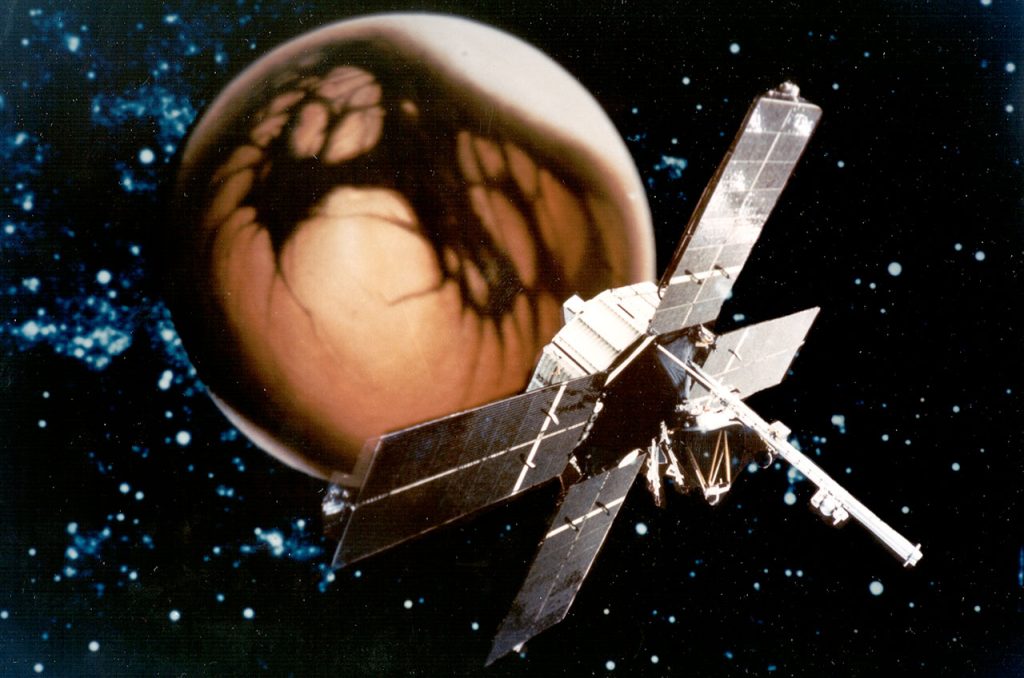Launch Date: November 28, 1964
Mission Type: Mars Flyby (Successful)
Operator: NASA – Jet Propulsion Laboratory (JPL)
On a cold morning in late November 1964, NASA launched Mariner 4, a spacecraft that would forever change how humanity saw the Red Planet. After the failure of Mariner 3 just weeks earlier, expectations were high—but cautious. No spacecraft had ever returned close-up images of another planet.
Mariner 4 succeeded where others had failed. It became the first mission to send back photographs from deep space, giving scientists a direct look at the surface of Mars and launching a new era in planetary exploration.
A Historic Journey
Mariner 4 launched aboard an Atlas-Agena D rocket on November 28, 1964, from Cape Kennedy. Its flight path took it across the solar system for more than seven months, eventually flying by Mars on July 14, 1965 at a distance of about 9,846 kilometers (6,118 miles).
As it passed Mars, the spacecraft snapped 21 images of the surface using a built-in television camera. These photos were stored on a magnetic tape recorder and slowly transmitted back to Earth over several days.
What It Found
The pictures revealed a barren, cratered landscape, far different from the Mars that many had imagined. Before Mariner 4, some scientists speculated that Mars might have rivers, vegetation, or even simple life. Instead, the images resembled the Moon—dry, dusty, and heavily marked by ancient impacts.
In addition to the photographs, Mariner 4 collected key data on the Martian atmosphere. It discovered that the planet’s air was much thinner than expected, made up mostly of carbon dioxide and far too weak to support liquid water on the surface.
Technical Specs
Mariner 4 was equipped with a suite of scientific instruments, including:
- Television Camera System (for imaging Mars)
- Magnetometer
- Cosmic Ray Telescope
- Radiation Detectors
- Solar Plasma Probe
The spacecraft was powered by solar panels and used a high-gain antenna to transmit data back to Earth. It weighed 260.8 kilograms and was designed to operate independently, navigating using solar orientation and gyroscopes.
The Human Side of Data
One of the most memorable aspects of the mission came during the slow transmission of the first image. Impatient to see the results, engineers at JPL hand-colored the numerical data values on a grid, turning the raw signal into a picture before the full electronic image was processed. It was the first time people saw a planet beyond Earth up close—even if it was only in colored pencil.
Legacy
Mariner 4’s discoveries dramatically reshaped public and scientific views of Mars. The dream of a lush, Earth-like Mars was set aside—at least for a while. But more importantly, the mission proved that interplanetary exploration was possible, reliable, and ready to deliver real science.
Its success laid the foundation for the rest of the Mariner program, including Mariner 9, the first Mars orbiter, and later missions like Viking, Pathfinder, and Curiosity.
Mariner 4 stopped transmitting in late 1967, but its legacy endures. The spacecraft is now silent and drifting in a solar orbit, a quiet ambassador from humanity’s first steps into the solar system.
Fast Facts
- Closest Approach to Mars: 9,846 km
- Total Images Taken: 21
- Total Mission Duration: ~3 years
- Power Source: Solar panels
- Firsts: First photos of another planet from space, first successful Mars flyby





